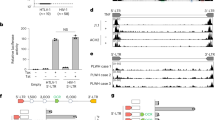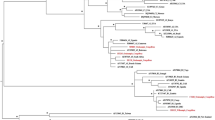Abstract
Human immunodeficiency virus type 1 (HIV-1) is the aetiologic agent of AIDS (acquired immune deficiency syndrome) in most countries1–3 and probably originated in Central Africa like the AIDS epidemic itself. Evidence for a second major group of human immunodeficiency-associated retroviruses came from a report that West African human populations4 like wild-caught African green monkeys5 had serum antibodies that reacted more strongly with a simian immunodeficiency virus (STLV-3Mac) (ref. 6) than with HIV-1. Novel T-lymphotropic retroviruses were reported to have been isolated from healthy Senegalese West Africans (HTLV-4) (ref. 4) and from African green monkeys (STLV-3AGM) (ref. 7), and a different retrovirus (HIV-2) was identified in other West African AIDS patients8. Genomic analysis of HIV-2 clearly distinguished it from STLV-3 (ref. 9), but restriction enzyme site-mapping of three different HTLV-4 isolates and six different STLV-3AGM isolates showed them to be essentially indistinguishable10–12. In this report we clone, restriction map, and partially sequence three isolates of HTLV-4 (PK82, PK289, PK190) (ref. 4). We find that these viruses differ in nucleotide sequence from each other and from three isolates of STLV-3AGM (K78, K6W, K1) (ref. 7) by 1% or less. We also report the isolation of a T-lymphotropic retrovirus from the peripheral blood of a healthy Senegalese woman which hybridizes preferentially to HIV-2 specific DNA probes. We conclude that HTLV-4 (ref. 4) and STLV-3AGM (ref. 7) are not independent virus isolates and that HIV-2 is present in Senegal as it is in other West African countries13.
This is a preview of subscription content, access via your institution
Access options
Subscribe to this journal
Receive 51 print issues and online access
$199.00 per year
only $3.90 per issue
Buy this article
- Purchase on SpringerLink
- Instant access to full article PDF
Prices may be subject to local taxes which are calculated during checkout
Similar content being viewed by others
References
1. Barre-Sinoussi, F. et al. Science 220, 868-871 (1983). 2. Popovic, M. et al. Science 224, 497-499 (1984). 3. Gallo, R. C. et al. Science 224, 500-503 (1984). 4. Kanki, P. J. et al. Science 232, 238-242 (1986). 5. Kanki, P. J. et al. Lancet i, 1330-1332 (1985). 6. Daniel, M. D. et al. Science 228, 1201-1204 (1985). 7. Kanki, P. J., Alroy, J. & Essex, M. Science 230, 951-954 (1985). 8. Clavel, F. et al. Science 233, 343-346 (1986). 9. Guyader, M. et al Nature 326, 662-669 (1987). 10. Hirsch, V. et al. Proc. natn. Acad. Sci. U.S.A. 83, 9754-9758 (1986). 11. Kornfeld, H. et al. Nature 326, 610-613 (1987). 12. Hirsch, V., Riedel, N. & Mullins, J. I. Cell 49, 307-319 (1987). 13. Clavel, F. et al. New EngL J. Med. 316, 1180-1185 (1987). 14. Chakrabarti, L. et al. Nature 328, 543-547 (1987). 15. Franchini, G. et al. Nature 328, 539-543 (1987). 16. Desrosiers, R. C. et al. Nature 327, 107 (1987). 17. Kanki, P. J. et al. Science 236, 827-831 (1987). 18. Shaw, G. M. et al. Science 226, 1165-1171 (1984). 19. Wong-Staal, F. et al. Science 229, 759-762 (1985). 20. Hahn, B. H. et al Science 232, 1548-1553 (1986). 21. Wilbur, W. J. & Lipman, D. J. Proc. natn. Acad. Sci. U.S.A. 80, 726-730 (1983).
Author information
Authors and Affiliations
Rights and permissions
About this article
Cite this article
Hahn, B., Kong, L., Lee, SW. et al. Relation of HTLV-4 to simian and human immunodeficiency-associated viruses. Nature 330, 184–186 (1987). https://doi.org/10.1038/330184a0
Received:
Accepted:
Issue date:
DOI: https://doi.org/10.1038/330184a0
This article is cited by
-
Comparison of simian immunodeficiency virus isolates
Nature (1988)
-
Comparison of simian immunodeficiency virus isolates
Nature (1988)
-
A case of mistaken non-identity
Nature (1988)
-
Biologically diverse molecular variants within a single HIV-1 isolate
Nature (1988)



